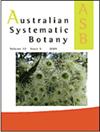基于蕨类植物系统发育群分类PPG I的澳大利亚石松属和蕨类植物的分类和类型划分
IF 1.6
3区 生物学
Q4 EVOLUTIONARY BIOLOGY
引用次数: 14
摘要
摘要更新了所有澳大利亚蕨类植物和石松属植物的分类和类型,以反映蕨类植物系统发育第一组分类和藻类、真菌和植物的国际命名规则,提出了8个新的命名组合和85个选型。自1998年出版《澳大利亚蕨类植物志》以来,澳大利亚蕨类植物区系包括2纲14目32科134属528种和亚种,此外还有8个新记录物种和6个新认可物种。总的来说,澳大利亚有208种特有物种,其中昆士兰州的物种多样性和特有性最高,豪勋爵岛的每单位面积物种和特有性集中度最高。澳大利亚蕨类植物和番茄植物区系与非洲、亚洲和大洋洲有着不同的联系,其中与亚洲和大洋州的重叠最大。澳大利亚+大洋洲的特有物种比澳大利亚+亚洲的特有物种多。与《澳大利亚植物志》中的分类相比,目前没有任何蕨类植物属和番茄属被认为是澳大利亚的完全特有植物。本文章由计算机程序翻译,如有差异,请以英文原文为准。
Classification and typification of Australian lycophytes and ferns based on Pteridophyte Phylogeny Group classification PPG I
Abstract. The classification and typification of all Australian ferns and lycophytes is updated to reflect the Pteridophyte Phylogeny Group I classification and the International Code of Nomenclature for algae, fungi, and plants, presenting 8 new nomenclatural combinations as well as 85 lectotypifications. The Australian fern and lycophyte flora comprises 2 classes, 14 orders, 32 families, 134 genera and 528 species and subspecies with the addition of 8 newly recorded and 6 newly recognised species since the publication of the Flora of Australia fern volume in 1998. Overall, 208 species are endemic to Australia, with Queensland having the highest species diversity and endemism by state or territory, and Lord Howe Island having the highest concentration of species and endemics per unit area. The Australian fern and lycophyte flora shows diverse links with Africa, Asia and Oceania, with the largest overlaps being shared with Asia and Oceania. More species are endemic to Australia+Oceania than to Australia+Asia. Contrasting with the classification presented in the Flora of Australia, no genera of ferns and lycophytes are now considered to be wholly endemic to Australia.
求助全文
通过发布文献求助,成功后即可免费获取论文全文。
去求助
来源期刊

Australian Systematic Botany
生物-进化生物学
CiteScore
3.10
自引率
12.50%
发文量
12
审稿时长
>12 weeks
期刊介绍:
Australian Systematic Botany is an international journal devoted to the systematics, taxonomy, and related aspects of biogeography and evolution of all algae, fungi and plants, including fossils. Descriptive taxonomic papers should normally constitute a comprehensive treatment of a group. Short papers on individual species and nomenclatural papers must contain significant new information of broader interest to be considered. The prestigious L.A.S. Johnson Review Series is published. Other review articles will also be considered. All papers are peer reviewed.
Australian Systematic Botany is published with the endorsement of the Commonwealth Scientific and Industrial Research Organisation (CSIRO) and the Australian Academy of Science.
 求助内容:
求助内容: 应助结果提醒方式:
应助结果提醒方式:


